Effect of Biochar on the Growth, Photosynthesis, Antioxidant System and Cadmium Content of Mentha piperita ‘Chocolate’ and Mentha spicata in Cadmium-Contaminated Soil
Abstract
1. Introduction
2. Materials and Methods
2.1. Test Materials and Growth Conditions
2.2. Determination of Assays and Contents
2.3. Statistical Analysis
3. Results
3.1. Soil Property
3.2. Growth Characteristics
3.3. Gas Exchange Parameters and Chlorophyll Content
3.4. Antioxidant Defense Responses
3.5. Cd Absorption and Distribution
4. Discussion
5. Conclusions
Author Contributions
Funding
Institutional Review Board Statement
Informed Consent Statement
Data Availability Statement
Conflicts of Interest
References
- Lei, K.; Pan, H.; Lin, C. A landscape approach towards ecological restoration and sustainable development of mining areas. Ecol. Eng. 2016, 90, 320–325. [Google Scholar] [CrossRef]
- Tauqeer, H.M.; Basharat, Z.; Ramzani, P.M.A.; Farhad, M.; Lewinska, K.; Turan, V.; Karczewska, A.; Khan, S.A.; Faran, G.-e.; Iqbal, M. Aspergillus niger-mediated release of phosphates from fish bone char reduces Pb phytoavailability in Pb-acid batteries polluted soil, and accumulation in fenugreek. Environ. Pollut. 2022, 313, 120064. [Google Scholar] [CrossRef]
- Pramanik, K.; Mandal, S.; Banerjee, S.; Ghosh, A.; Maiti, T.K.; Mandal, N.C. Unraveling the heavy metal resistance and biocontrol potential of Pseudomonas sp. K32 strain facilitating rice seedling growth under Cd stress. Chemosphere 2021, 274, 129819. [Google Scholar] [CrossRef]
- Qi, F.; Fu, T.; Gao, H.; Liu, J. Review on Cadmium Pollution from Sewage Irrigation in Farmland Soil. J. Ecol. Rural Environ. 2022, 38, 10–20. [Google Scholar]
- Dinu, C.; Gheorghe, S.; Tenea, A.G.; Stoica, C.; Vasile, G.-G.; Popescu, R.L.; Serban, E.A.; Pascu, L.F. Toxic Metals (As, Cd, Ni, Pb) Impact in the Most Common Medicinal Plant (Mentha piperita). Int. J. Environ. Res. Public Health 2021, 18, 3904. [Google Scholar] [CrossRef]
- Hasanpour, R.; Zaefarian, F.; Rezvani, M.; Jalili, B. Potential of Mentha aquatica L., Eryngium caucasicum Trautv. and Froriepia subpinnata Ledeb. for phytoremediation of Cd-contaminated soil. Braz. J. Bot. 2019, 42, 399–406. [Google Scholar] [CrossRef]
- Nigam, N.; Khare, P.; Yadav, V.; Mishra, D.; Jain, S.; Karak, T.; Panja, S.; Tandon, S. Biochar-mediated sequestration of Pb and Cd leads to enhanced productivity in Mentha arvensis. Ecotoxicol. Environ. Saf. 2019, 172, 411–422. [Google Scholar] [CrossRef]
- Karak, T.; Bhattacharyya, P.; Paul, R.K.; Das, D.K. Metal accumulation, biochemical response and yield of Indian mustard grown in soil amended with rural roadside pond sediment. Ecotoxicol. Environ. Saf. 2013, 92, 161–173. [Google Scholar] [CrossRef]
- Abbott, L.K.; Macdonald, L.M.; Wong, M.T.F.; Webb, M.J.; Jenkins, S.N.; Farrell, M. Potential roles of biological amendments for profitable grain production—A review. Agric. Ecosyst. Environ. 2018, 256, 34–50. [Google Scholar] [CrossRef]
- Yan, J.; Yu, P.; Liu, C.; Li, Q.; Gu, M. Replacing peat moss with mixed hardwood biochar as container substrates to produce five types of mint (Mentha spp.). Ind. Crops Prod. 2020, 155. [Google Scholar] [CrossRef]
- Yu, P.; Huang, L.; Li, Q.; Lima, I.M.; White, P.M.; Gu, M. Effects of Mixed Hardwood and Sugarcane Biochar as Bark-Based Substrate Substitutes on Container Plants Production and Nutrient Leaching. Agron.-Basel 2020, 10, 156. [Google Scholar] [CrossRef]
- Zhang, C.; Shan, B.; Zhu, Y.; Tang, W. Remediation effectiveness of Phyllostachys pubescens biochar in reducing the bioavailability and bioaccumulation of metals in sediments. Environ. Pollut. 2018, 242, 1768–1776. [Google Scholar] [CrossRef]
- Irshad, M.K.; Noman, A.; Alhaithloul, H.A.S.; Adeel, M.; Rui, Y.; Shah, T.; Zhu, S.; Shang, J. Goethite-modified biochar ameliorates the growth of rice (Oryza sativa L.) plants by suppressing Cd and As-induced oxidative stress in Cd and As co-contaminated paddy soil. Sci. Total Environ. 2020, 717, 137086. [Google Scholar] [CrossRef]
- Ali, A.; Guo, D.; Jeyasundar, P.G.; Li, Y.; Xiao, R.; Du, J.; Li, R.; Zhang, Z. Application of wood biochar in polluted soils stabilized the toxic metals and enhanced wheat (Triticum aestivum) growth and soil enzymatic activity. Ecotoxicol. Environ. Saf. 2019, 184, 109635. [Google Scholar] [CrossRef]
- Rafique, M.; Ortas, I.; Rizwan, M.; Sultan, T.; Chaudhary, H.J.; Isik, M.; Aydin, O. Effects of Rhizophagus clarus and biochar on growth, photosynthesis, nutrients, and cadmium (Cd) concentration of maize (Zea mays) grown in Cd-spiked soil. Environ. Sci. Pollut. Res. 2019, 26, 20689–20700. [Google Scholar] [CrossRef]
- Bashir, S.; Qayyum, M.A.; Husain, A.; Bakhsh, A.; Ahmed, N.; Hussain, M.B.; Elshikh, M.S.; Alwahibi, M.S.; Almunqedhi, B.M.A.; Hussain, R.; et al. Efficiency of different types of biochars to mitigate Cd stress and growth of sunflower (Helianthus; L.) in wastewater irrigated agricultural soil. Saudi J. Biol. Sci. 2021, 28, 2453–2459. [Google Scholar] [CrossRef]
- Tan, X.; Liu, Y.; Zeng, G.; Wang, X.; Hu, X.; Gu, Y.; Yang, Z. Application of biochar for the removal of pollutants from aqueous solutions. Chemosphere 2015, 125, 70–85. [Google Scholar] [CrossRef]
- Zubair, M.; Ramzani, P.M.A.; Rasool, B.; Khan, M.A.; Ur-Rahman, M.; Akhtar, I.; Turan, V.; Tauqeer, H.M.; Farhad, M.; Khan, S.A.; et al. Efficacy of chitosan-coated textile waste biochar applied to Cd-polluted soil for reducing Cd mobility in soil and its distribution in moringa (Moringa oleifera L.). J. Environ. Manag. 2021, 284, 112047. [Google Scholar] [CrossRef]
- Rasool, B.; Mahmood-ur-Rahman; Zubair, M.; Khan, M.A.; Ramzani, P.M.A.; Dradrach, A.; Turan, V.; Iqbal, M.; Khan, S.A.; Tauqeer, H.M.; et al. Synergetic Efficacy of Amending Pb-Polluted Soil with P-Loaded Jujube (Ziziphus mauritiana) Twigs Biochar and Foliar Chitosan Application for Reducing Pb Distribution in Moringa Leaf Extract and Improving Its Anti-cancer Potential. Water Air Soil Pollut. 2022, 233, 344. [Google Scholar] [CrossRef]
- Turan, V. Arbuscular mycorrhizal fungi and pistachio husk biochar combination reduces Ni distribution in mungbean plant and improves plant antioxidants and soil enzymes. Physiol. Plant. 2021, 173, 418–429. [Google Scholar] [CrossRef]
- Turan, V. Calcite in combination with olive pulp biochar reduces Ni mobility in soil and its distribution in chili plant. Int. J. Phytoremediation 2022, 24, 166–176. [Google Scholar] [CrossRef]
- Zhang, F.; Liu, M.; Li, Y.; Che, Y.; Xiao, Y. Effects of arbuscular mycorrhizal fungi, biochar and cadmium on the yield and element uptake of Medicago sativa. Sci. Total Environ. 2019, 655, 1150–1158. [Google Scholar] [CrossRef]
- Giannopolitis, C.N.; Ries, S.K. Superoxide dismutases: I. Occurrence in higher plants. Plant. Physiol. 1977, 59, 309–314. [Google Scholar] [CrossRef]
- Tuna, A.L.; Kaya, C.; Dikilitas, M.; Yokas, I.; Burun, B.; Altunlu, H. Comparative effects of various salicylic acid derivatives on key growth parameters and some enzyme activities in salinity stressed maize (Zea mays L.) plants. Pak. J. Bot. 2007, 39, 787–798. [Google Scholar] [CrossRef]
- Seckin, B.; Sekmen, A.H.; Turkan, I. An Enhancing Effect of Exogenous Mannitol on the Antioxidant Enzyme Activities in Roots of Wheat Under Salt Stress. J. Plant. Growth Regul. 2009, 28, 12–20. [Google Scholar] [CrossRef]
- Farhangi-Abriz, S.; Torabian, S. Antioxidant enzyme and osmotic adjustment changes in bean seedlings as affected by biochar under salt stress. Ecotoxicol. Environ. Saf. 2017, 137, 64–70. [Google Scholar] [CrossRef]
- Kim, D.O.; Jeong, S.W.; Lee, C.Y. Antioxidant capacity of phenolic phytochemicals from various cultivars of plums. Food Chem. 2003, 81, 321–326. [Google Scholar] [CrossRef]
- Zhishen, J.; Mengcheng, T.; Jianming, W. The determination of flavonoid contents in mulberry and their scavenging effects on superoxide radicals. Food Chem. 1999, 64, 555–559. [Google Scholar] [CrossRef]
- Xu, L.; Chen, H.; Zhang, T.; Deng, Y.; Yan, J.; Wang, L. Salicylic Acid Improves the Salt Tolerance Capacity of Saponaria officinalis by Modulating Its Photosynthetic Rate, Osmoprotectants, Antioxidant Levels, and Ion Homeostasis. Agron.-Basel 2022, 12, 1443. [Google Scholar] [CrossRef]
- Baczek-Kwinta, R.; Antonkiewicz, J. Differential Physiological Response and Potential Toxicological Risk of White Cabbage Grown in Zinc-Spiked Soil. Agron.-Basel 2022, 12, 2186. [Google Scholar] [CrossRef]
- Pourghasemian, N.; Ehsanzadeh, P.; Greger, M. Genotypic variation in safflower (Carthamus spp.) cadmium accumulation and tolerance affected by temperature and cadmium levels. Environ. Exp. Bot. 2013, 87, 218–226. [Google Scholar] [CrossRef]
- Yadav, V.; Jain, S.; Mishra, P.; Khare, P.; Shukla, A.K.; Karak, T.; Singh, A.K. Amelioration in nutrient mineralization and microbial activities of sandy loam soil by short term field aged biochar. Appl. Soil Ecol. 2019, 138, 144–155. [Google Scholar] [CrossRef]
- Liao, X.; Kang, H.; Haidar, G.; Wang, W.; Malghani, S. The impact of biochar on the activities of soil nutrients acquisition enzymes is potentially controlled by the pyrolysis temperature: A meta-analysis. Geoderma 2022, 411, 115692. [Google Scholar] [CrossRef]
- Chen, K.; Li, N.; Zhang, S.; Liu, N.; Yang, J.; Zhan, X.; Han, X. Biochar-induced changes in the soil diazotroph community abundance and structure in a peanut field trial. Biochar 2022, 4, 26. [Google Scholar] [CrossRef]
- Bashir, S.; Rehman, M.; Yousaf, M.; Salam, A.; Gulshan, A.B.; Iqbal, J.; Aziz, I.; Azeem, M.; Rukh, S.; Asghar, R.M.A. Comparative efficiency of wheat straw and sugarcane bagasse biochar reduces the cadmium bioavailability to spinach and enhances the microbial activity in contaminated soil. Int. J. Phytoremediation 2019, 21, 1098–1103. [Google Scholar] [CrossRef]
- Turan, V.; Ramzani, P.M.A.; Ali, Q.; Abbas, F.; Iqbal, M.; Irum, A.; Khan, W.-u.-D. Alleviation of nickel toxicity and an improvement in zinc bioavailability in sunflower seed with chitosan and biochar application in pH adjusted nickel contaminated soil. Arch. Agron. Soil Sci. 2018, 64, 1053–1067. [Google Scholar] [CrossRef]
- Song, X.; Yue, X.; Chen, W.; Jiang, H.; Han, Y.; Li, X. Detection of Cadmium Risk to the Photosynthetic Performance of Hybrid Pennisetum. Front. Plant Sci. 2019, 10, 798. [Google Scholar] [CrossRef]
- Haider, F.U.; Virk, A.L.; Rehmani, M.I.A.; Skalicky, M.; Ata-ul-Karim, S.T.; Ahmad, N.; Soufan, W.; Brestic, M.; Sabagh, A.E.L.; Liqun, C. Integrated Application of Thiourea and Biochar Improves Maize Growth, Antioxidant Activity and Reduces Cadmium Bioavailability in Cadmium-Contaminated Soil. Front. Plant. Sci. 2022, 12, 809322. [Google Scholar] [CrossRef]
- Considine, M.J.; Foyer, C.H. Oxygen and reactive oxygen species-dependent regulation of plant growth and development. Plant. Physiol. 2021, 186, 79–92. [Google Scholar] [CrossRef]
- Rahman, M.M.; Mostofa, M.G.; Keya, S.S.; Siddiqui, M.N.; Ansary, M.M.U.; Das, A.K.; Rahman, M.A.; Tran, L.S.-P. Adaptive Mechanisms of Halophytes and Their Potential in Improving Salinity Tolerance in Plants. Int. J. Mol. Sci. 2021, 22, 10733. [Google Scholar] [CrossRef]
- Nigam, N.; Yadav, V.; Khare, P.; Singh, R.P.; Das, P.; Shanker, K.; Sharma, R.S. Exploring the benefits of biochar over other organic amendments for reducing of metal toxicity in Withania somnifera. Biochar 2019, 1, 293–307. [Google Scholar] [CrossRef]
- Kosolsaksakul, P.; Oliver, I.W.; Graham, M.C. Evaluating cadmium bioavailability in contaminated rice paddy soils and assessing potential for contaminant immobilisation with biochar. J. Environ. Manag. 2018, 215, 49–56. [Google Scholar] [CrossRef] [PubMed]
- Zheng, R.; Sun, G.; Li, C.; Reid, B.J.; Xie, Z.; Zhang, B.; Wang, Q. Mitigating cadmium accumulation in greenhouse lettuce production using biochar. Environ. Sci. Pollut. Res. 2017, 24, 6532–6542. [Google Scholar] [CrossRef] [PubMed]
- Mehmood, S.; Saeed, D.A.; Rizwan, M.; Khan, M.N.; Aziz, O.; Bashir, S.; Ibrahim, M.; Ditta, A.; Akmal, M.; Mumtaz, M.A.; et al. Impact of different amendments on biochemical responses of sesame (Sesamum indicum L.) plants grown in lead-cadmium contaminated soil. Plant Physiol. Biochem. 2018, 132, 345–355. [Google Scholar] [CrossRef]
- Khan, K.Y.; Ali, B.; Cui, X.; Feng, Y.; Yang, X.; Stoffella, P.J. Impact of different feedstocks derived biochar amendment with cadmium low uptake affinity cultivar of pak choi (Brassica rapa ssb. chinensis L.) on phytoavoidation of Cd to reduce potential dietary toxicity. Ecotoxicol. Environ. Saf. 2017, 141, 129–138. [Google Scholar] [CrossRef]
- Kang, X.; Geng, N.; Li, X.; Yu, J.; Wang, H.; Pan, H.; Yang, Q.; Zhuge, Y.; Lou, Y. Biochar Alleviates Phytotoxicity by Minimizing Bioavailability and Oxidative Stress in Foxtail Millet (Setaria italica L.) Cultivated in Cd- and Zn-Contaminated Soil. Front. Plant. Sci. 2022, 13, 782963. [Google Scholar] [CrossRef]
- Turan, V.; Khan, S.A.; Mahmood-ur-Rahman; Iqbal, M.; Ramzani, P.M.A.; Fatima, M. Promoting the productivity and quality of brinjal aligned with heavy metals immobilization in a wastewater irrigated heavy metal polluted soil with biochar and chitosan. Ecotoxicol. Environ. Saf. 2018, 161, 409–419. [Google Scholar] [CrossRef]
- Ma, J.; Ni, X.; Huang, Q.; Liu, D.; Ye, Z. Effect of bamboo biochar on reducing grain cadmium content in two contrasting wheat genotypes. Environ. Sci. Pollut. Res. 2021, 28, 17405–17416. [Google Scholar] [CrossRef]
- Lu, K.; Yang, X.; Shen, J.; Robinson, B.; Huang, H.; Liu, D.; Bolan, N.; Pei, J.; Wang, H. Effect of bamboo and rice straw biochars on the bioavailability of Cd, Cu, Pb and Zn to Sedum plumbizincicola. Agric. Ecosyst. Environ. 2014, 191, 124–132. [Google Scholar] [CrossRef]
- Xu, C.; Zhao, J.; Yang, W.; He, L.; Wei, W.; Tan, X.; Wang, J.; Lin, A. Evaluation of biochar pyrolyzed from kitchen waste, corn straw, and peanut hulls on immobilization of Pb and Cd in contaminated soil. Environ. Pollut. 2020, 261, 114133. [Google Scholar] [CrossRef]
- Qiu, Z.; Tang, J.; Chen, J.; Zhang, Q. Remediation of cadmium-contaminated soil with biochar simultaneously improves biochar’s recalcitrance. Environ. Pollut. 2020, 256, 113436. [Google Scholar] [CrossRef] [PubMed]
- Bashir, S.; Ali, U.; Shaaban, M.; Gulshan, A.B.; Iqbal, J.; Khan, S.; Husain, A.; Ahmed, N.; Mehmood, S.; Kamran, M.; et al. Role of sepiolite for cadmium (Cd) polluted soil restoration and spinach growth in wastewater irrigated agricultural soil. J. Environ. Manag. 2020, 258, 110020. [Google Scholar] [CrossRef] [PubMed]
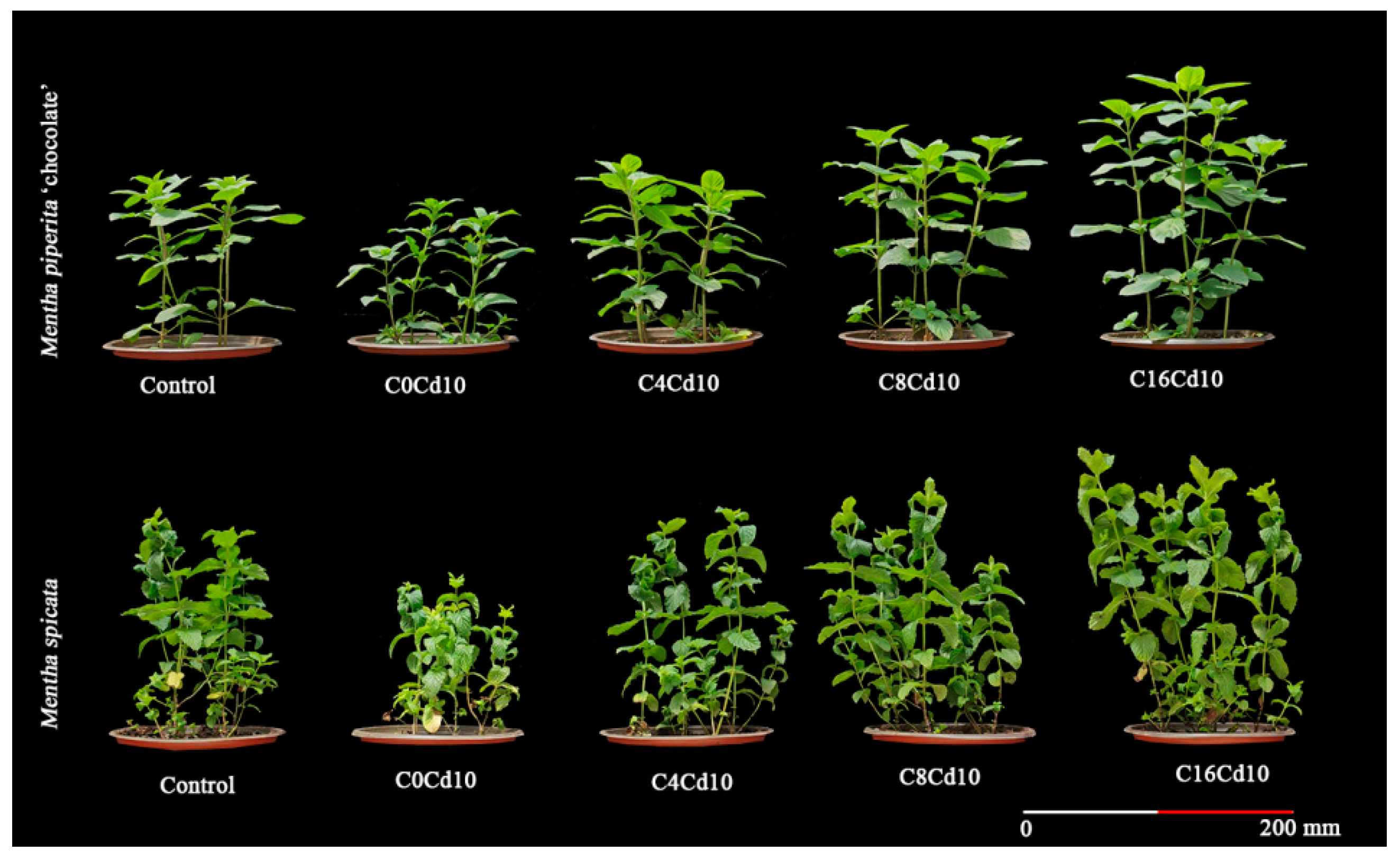
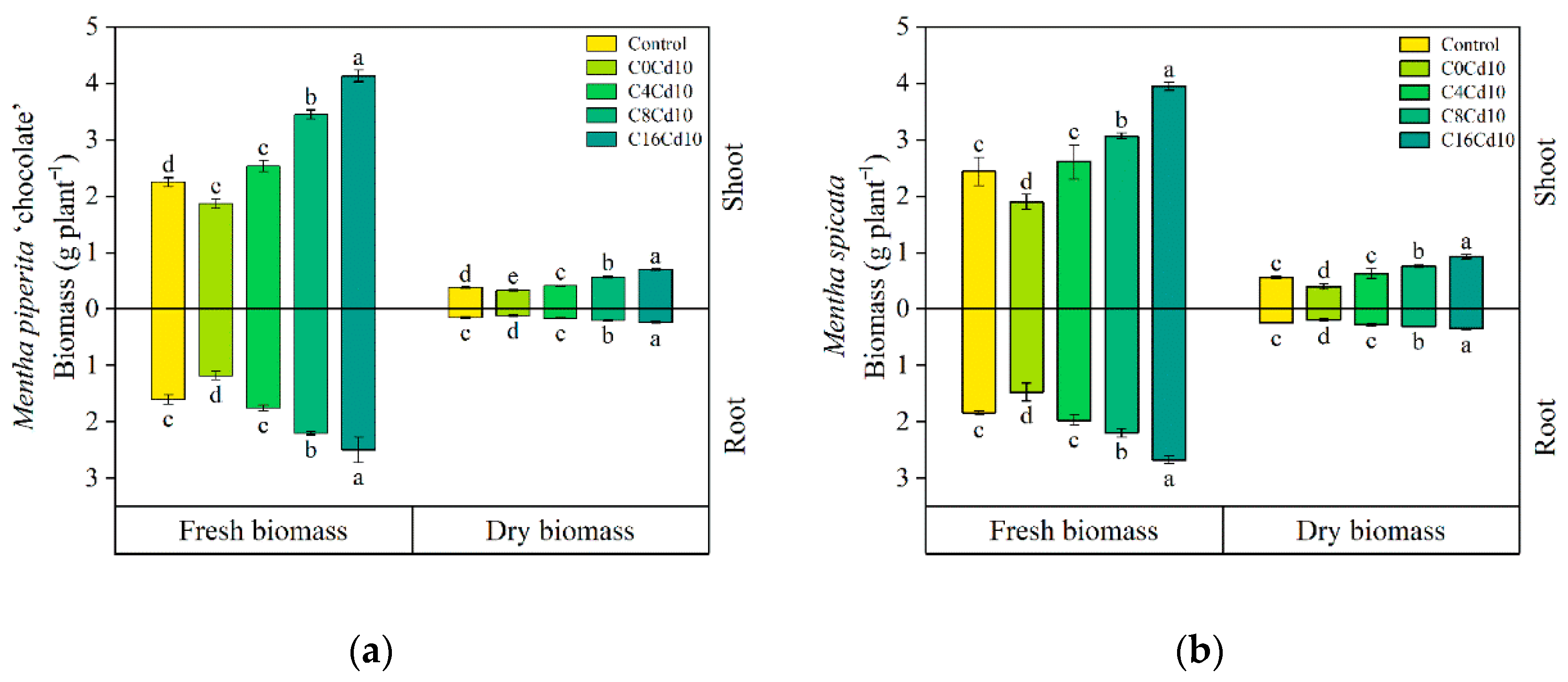
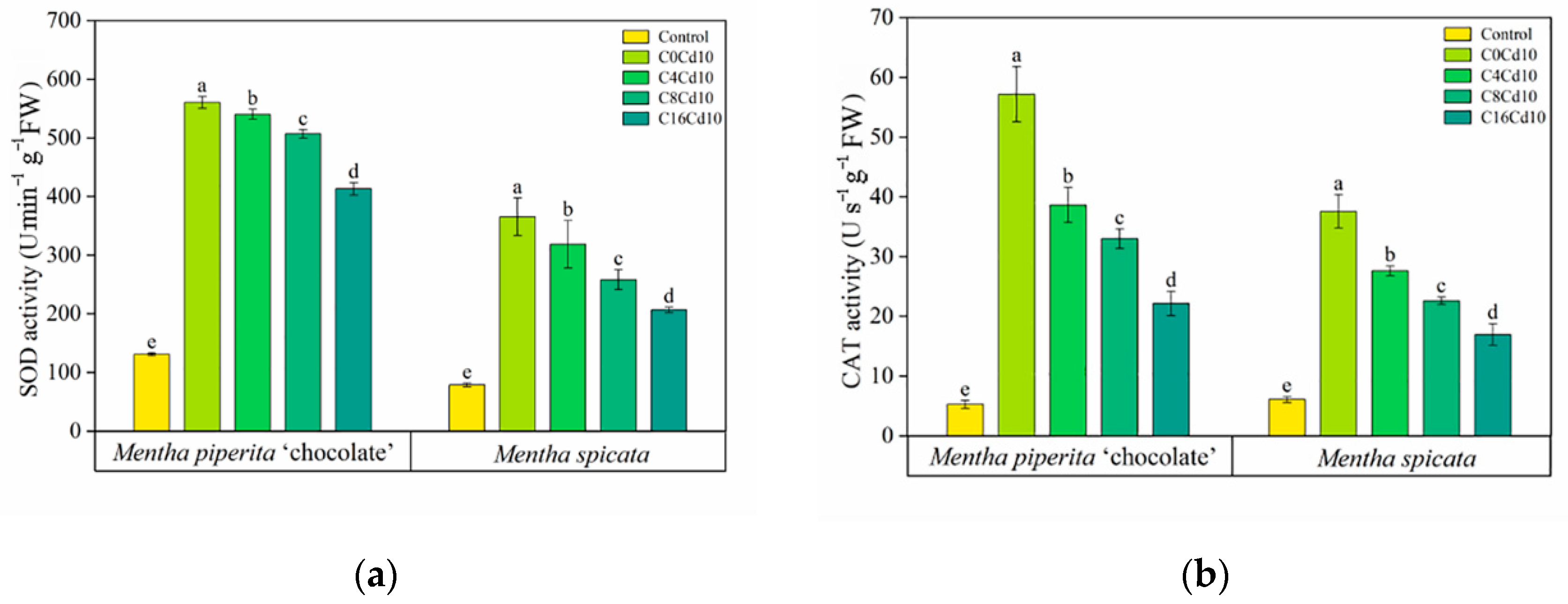
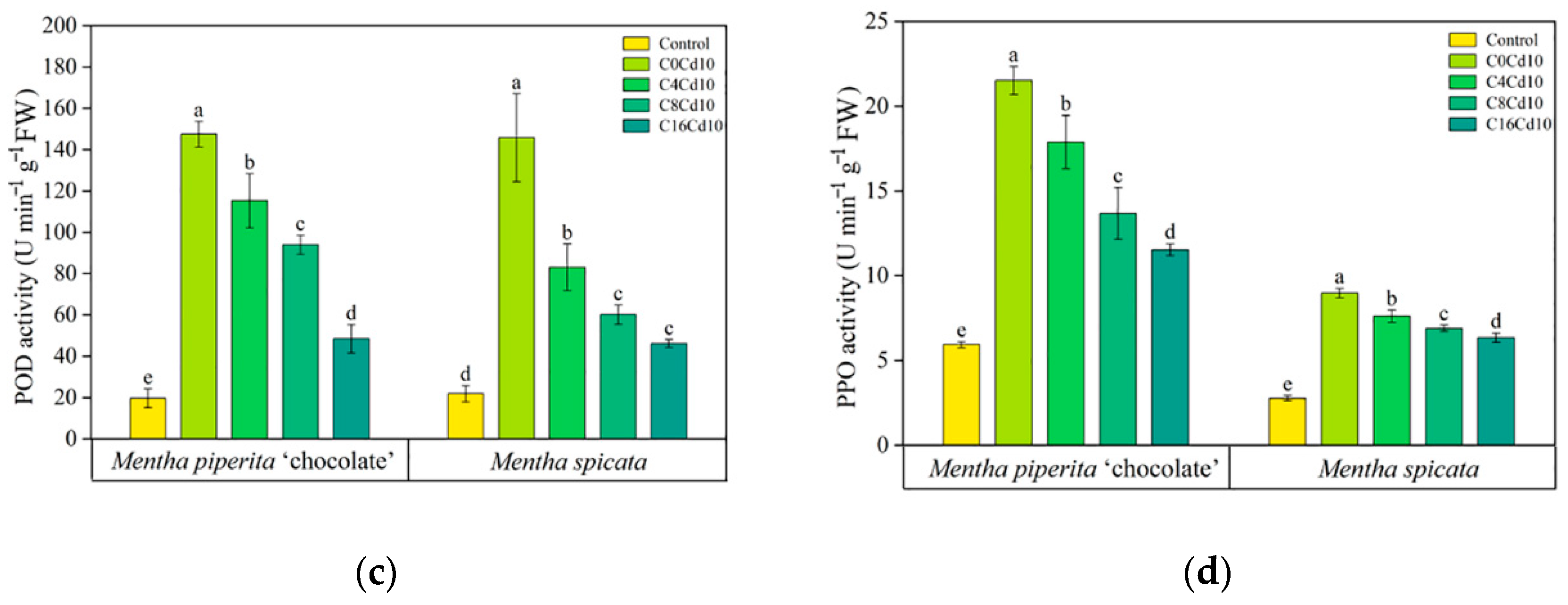

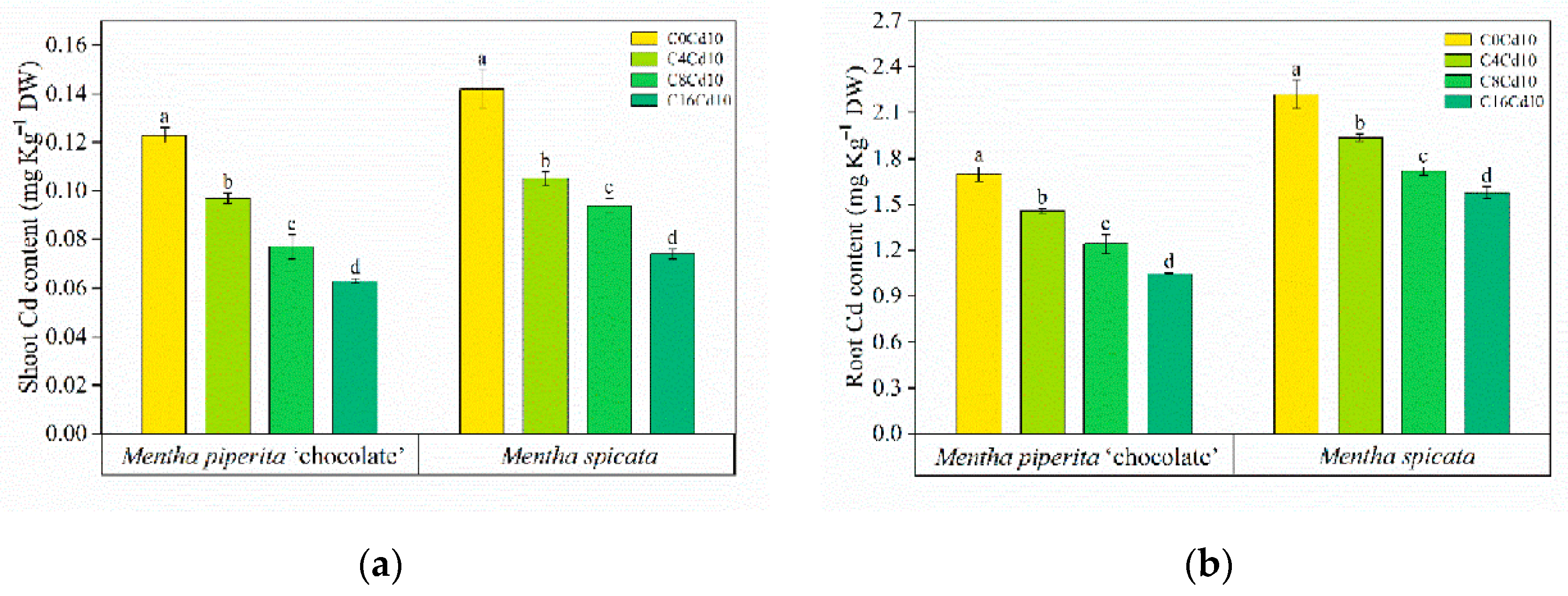
| Properties | Soil | Biochar |
|---|---|---|
| Bulk density (g cm−3) | 0.59 | 0.19 |
| Water holding capacity (%) | 59.68 | 252.72 |
| Total porosity (%) | 66.38 | 72.02 |
| Cd (mg Kg−1) | ND | ND |
| Available N (μg g−1) | 98.87 | 51.3 |
| Available P (μg g−1) | 12.51 | 205.42 |
| Available K (μg g−1) | 263.07 | 3022.39 |
| pH | 5.57 | 9.92 |
| Total organic carbon (%) | 15.69 | 53.11 |
| Plant | Treatments | Available N (μg g−1) | Available P (μg g−1) | Available K (μg g−1) | pH |
|---|---|---|---|---|---|
| Mentha piperita ‘chocolate’ | Control | 84.88 ± 2.45 c | 6.83 ± 0.8 d | 107.19 ± 0.42 d | 5.7 ± 0.06 d |
| C0Cd10 | 88.14 ± 3.51 c | 6.59 ± 0.71 d | 106.21 ± 0.46 d | 5.31 ± 0.08 e | |
| C4Cd10 | 101.91 ± 3.45 b | 20.81 ± 0.65 c | 155.1 ± 0.79 c | 5.9 ± 0.11 c | |
| C8Cd10 | 107.63 ± 4.94 ab | 28.73 ± 2.48 b | 164.12 ± 0.58 b | 6.06 ± 0.06 b | |
| C16Cd10 | 113.11 ± 3.16 a | 41.37 ± 1.5 a | 182.57 ± 0.89 a | 6.22 ± 0.05 a | |
| Mentha spicata | Control | 97.71 ± 1.46 ab | 10.02 ± 1.08 d | 93.1 ± 3.23 d | 5.49 ± 0.27 c |
| C0Cd10 | 95.38 ± 4.13 b | 8.31 ± 0.81 d | 91.01 ± 4.05 d | 5.13 ± 0.06 d | |
| C4Cd10 | 98.53 ± 5.05 ab | 20.95 ± 0.58 c | 130.13 ± 9.05 c | 5.93 ± 0.12 b | |
| C8Cd10 | 103.89 ± 3.52 a | 30.54 ± 2.09 b | 148.24 ± 1.27 b | 6.08 ± 0.13 ab | |
| C16Cd10 | 102.26 ± 4.06 ab | 43.85 ± 2.56 a | 177.16 ± 0.83 a | 6.31 ± 0.05 a |
| Plant | Treatments | Height (cm) | Leaf Length (mm) | Leaf Width (mm) |
|---|---|---|---|---|
| Mentha piperita ‘chocolate’ | Control | 14.9 ± 0.2 d | 31.66 ± 0.29 c | 23.06 ± 0.27 c |
| C0Cd10 | 13.03 ± 0.31 e | 30.62 ± 0.33 d | 21.45 ± 0.36 d | |
| C4Cd10 | 15.77 ± 0.35 c | 31.94 ± 0.44 c | 23.68 ± 0.15 bc | |
| C8Cd10 | 18.67 ± 0.25 b | 33.27 ± 0.14 b | 24.56 ± 0.22 b | |
| C16Cd10 | 20.93 ± 0.65 a | 35.94 ± 0.65 a | 26.74 ± 1.18 a | |
| Mentha spicata | Control | 14.97 ± 0.21 d | 30.6 ± 0.55 c | 20.89 ± 0.43 c |
| C0Cd10 | 13.4 ± 0.46 e | 28.52 ± 1.09 d | 18.86 ± 0.35 d | |
| C4Cd10 | 16.37 ± 0.45 c | 31.7 ± 0.27 bc | 21.4 ± 0.38 c | |
| C8Cd10 | 17.67 ± 0.4 b | 32.69 ± 0.57 b | 22.04 ± 0.17 b | |
| C16Cd10 | 19.83 ± 0.42 a | 34.7 ± 0.92 a | 23 ± 0.09 a |
| Plant | Treatments | Photosynthetic Rate (μmol m−2 s−1) | Transpiration Rate (mmol m−2 s−1) | Stomatal Conductance (mol m−2 s−1) | Chlorophyll Content (mg g−1 FW) |
|---|---|---|---|---|---|
| Mentha piperita ‘chocolate’ | Control | 10.852 ± 0.08 d | 1.719 ± 0.005 c | 0.045 ± 0.001 c | 2.265 ± 0.046 d |
| C0Cd10 | 8.275 ± 0.366 e | 1.268 ± 0.032 e | 0.035 ± 0.005 d | 2.037 ± 0.006 e | |
| C4Cd10 | 11.562 ± 0.562 c | 1.549 ± 0.018 d | 0.042 ± 0.001 c | 2.564 ± 0.016 c | |
| C8Cd10 | 13.832 ± 0.334 b | 2.054 ± 0.003 b | 0.053 ± 0.002 b | 2.639 ± 0.029 b | |
| C16Cd10 | 17.589 ± 0.297 a | 2.49 ± 0.004 a | 0.063 ± 0.002 a | 2.839 ± 0.045 a | |
| Mentha spicata | Control | 6.404 ± 0.205 d | 1.468 ± 0.032 c | 0.046 ± 0.001 b | 2.338 ± 0.01 d |
| C0Cd10 | 5.706 ± 0.273 e | 1.23 ± 0.116 d | 0.033 ± 0.006 c | 2.009 ± 0.025 e | |
| C4Cd10 | 7.299 ± 0.211 c | 1.827 ± 0.003 b | 0.043 ± 0.001 b | 2.644 ± 0.041 c | |
| C8Cd10 | 9.006 ± 0.297 b | 2.406 ± 0.001 a | 0.061 ± 0.001 a | 2.781 ± 0.045 b | |
| C16Cd10 | 12.166 ± 0.269 a | 2.478 ± 0.006 a | 0.065 ± 0.002 a | 3.003 ± 0.026 a |
| Plant | Treatments | Translocation Factors (TF) | Bioconcentration Factors (BCF) |
|---|---|---|---|
| Mentha piperita ‘chocolate’ | C0Cd10 | 0.073 ± 0.003 a | 0.182 ± 0.005 a |
| C4Cd10 | 0.066 ± 0.002 b | 0.155 ± 0.002 b | |
| C8Cd10 | 0.062 ± 0.002 c | 0.132 ± 0.007 c | |
| C16Cd10 | 0.06 ± 0.001 c | 0.111 ± 0.001 d | |
| Mentha spicata | C0Cd10 | 0.064 ± 0.001 a | 0.236 ± 0.01 a |
| C4Cd10 | 0.054 ± 0.002 b | 0.204 ± 0.002 b | |
| C8Cd10 | 0.055 ± 0.001 b | 0.181 ± 0.003 c | |
| C16Cd10 | 0.047 ± 0.001 c | 0.165 ± 0.004 d |
Publisher’s Note: MDPI stays neutral with regard to jurisdictional claims in published maps and institutional affiliations. |
© 2022 by the authors. Licensee MDPI, Basel, Switzerland. This article is an open access article distributed under the terms and conditions of the Creative Commons Attribution (CC BY) license (https://creativecommons.org/licenses/by/4.0/).
Share and Cite
Jiang, W.; Xu, L.; Liu, Y.; Su, W.; Yan, J.; Xu, D. Effect of Biochar on the Growth, Photosynthesis, Antioxidant System and Cadmium Content of Mentha piperita ‘Chocolate’ and Mentha spicata in Cadmium-Contaminated Soil. Agronomy 2022, 12, 2737. https://doi.org/10.3390/agronomy12112737
Jiang W, Xu L, Liu Y, Su W, Yan J, Xu D. Effect of Biochar on the Growth, Photosynthesis, Antioxidant System and Cadmium Content of Mentha piperita ‘Chocolate’ and Mentha spicata in Cadmium-Contaminated Soil. Agronomy. 2022; 12(11):2737. https://doi.org/10.3390/agronomy12112737
Chicago/Turabian StyleJiang, Wantong, Lingxin Xu, Yule Liu, Wenxin Su, Junxin Yan, and Dawei Xu. 2022. "Effect of Biochar on the Growth, Photosynthesis, Antioxidant System and Cadmium Content of Mentha piperita ‘Chocolate’ and Mentha spicata in Cadmium-Contaminated Soil" Agronomy 12, no. 11: 2737. https://doi.org/10.3390/agronomy12112737
APA StyleJiang, W., Xu, L., Liu, Y., Su, W., Yan, J., & Xu, D. (2022). Effect of Biochar on the Growth, Photosynthesis, Antioxidant System and Cadmium Content of Mentha piperita ‘Chocolate’ and Mentha spicata in Cadmium-Contaminated Soil. Agronomy, 12(11), 2737. https://doi.org/10.3390/agronomy12112737







